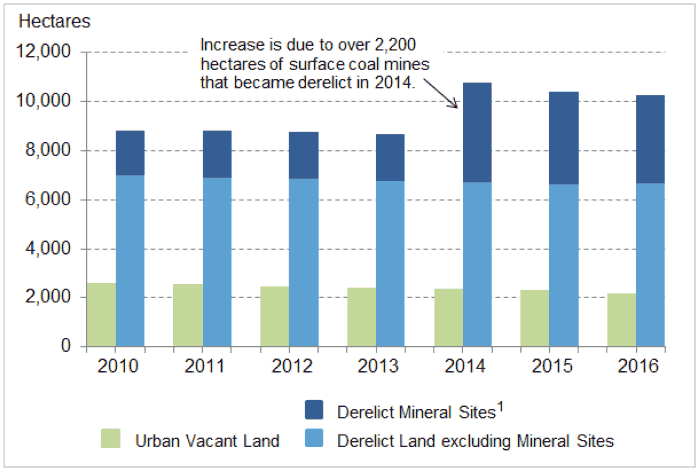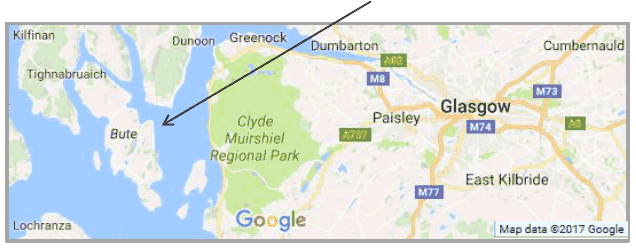Scottish vacant and derelict land survey 2016
Data collection publication undertaken to establish the extent and state of vacant and derelict land in Scotland.
1 Background to the survey
1.1 The Scottish Vacant and Derelict Land Survey ( SVDLS) is a data collection undertaken to establish the extent and state of vacant and derelict land in Scotland. The survey has been operating since 1988, and is managed by the Scottish Government Communities Analysis Division. The data is sourced from local authorities and the Loch Lomond and Trossachs National Park Authority. Most authorities submit data annually with a Survey base date of 31st March. This bulletin presents a summary of the results.
Chart 1: Total Derelict and Urban Vacant Land,
2010-2016

1. Mineral sites include sites where there was previously
coal, crushed rock, sand/gravel, shale, fireclay, limestone or
other mineral activity.
1.2 In 2014 an additional 2,217 hectares of derelict land were included to incorporate areas of former surface coal mine sites in East Ayrshire which became derelict following the liquidation of Scottish Coal and ATH Resources in 2013.
1.3 Excel versions of tables are available on the Planning Statistics webpages, along with a site-level dataset and selected maps and charts. These are published at: http://www.gov.scot/Topics/Statistics/Browse/Planning/Publications
1.4 The main purpose of these statistics is to provide the evidence base for monitoring the extent and state of urban vacant and derelict land, the remediation of vacant and derelict land and progress in bringing it into re-use, and to inform the programming of rehabilitation, planning and reuse of urban vacant and derelict sites. The statistics are used by the Scottish Government to help allocate and monitor the impact of the Vacant and Derelict Land Fund ( VDLF). The VDLF is one of three elements of the Capital Investment Fund, which supports physical development and focuses on key regeneration interventions.
1.5 The statistics contribute to the Government's performance indicator for sustainable communities that measures progress on Housing and Regeneration outcomes. Further information on this can be found at: http://www.gov.scot/About/Performance/scotPerforms/partnerstories/HARO/Indicators.
1.6 Other uses of the statistics by Scottish Government and other stakeholders are published at: http://www.gov.scot/Topics/Statistics/Browse/Planning/DataUses
1.7 Dumfries & Galloway, East Lothian, Highland and West Lothian did not update their survey in 2016 and so data for these local authorities is carried over from 2015 in this report. Annex Table E records local authority annual participation in the survey each year since 1996.
1.8 During the collection of the 2016 survey data some previous survey returns for the years 2010 to 2015 have been revised to remove sites that have been taken out of the survey for definitional reasons (for example, when new information comes to light such as a presumption about ground contaminants from a previous use has been shown to be incorrect and so the site no longer meets the criteria for vacant or derelict land). There were a total of 42 sites (165 hectares) naturalised or removed for definitional reasons in the 2016 survey. In addition, some previous survey returns have also been revised to incorporate updates to underlying data. This revisions process is carried out so that any time series analysis presented within this bulletin is as accurate as possible. Further information is available in section A.4 of the Annex, along with unrevised historical data for 1996 to 2009.
1.9 Vacant land is land which is unused for the purposes for which it is held and is viewed as an appropriate site for development. This land must either have had prior development on it or preparatory work has taken place in anticipation of future development.
2.0 The main part of this bulletin covers vacant land (referred to as Urban Vacant) that is located within settlements of over 2,000 in population (as defined in council local plans, see Annex Section A.7). Some local authorities have also surveyed for vacant land within settlements of under 2,000 in population. Further information on those results can be found in Annex Table B.
2.1 Derelict land (and buildings) is land which has been so damaged by development, that it is incapable of development for beneficial use without rehabilitation. In addition the land must currently not be used for the purpose for which it is held or a use acceptable in the local plan. Land also qualifies as derelict if it has an un-remedied previous use which could constrain future development. For both vacant and derelict land, site records must be at least 0.1 hectares in size to be included.
Presentation of figures in the bulletin throughout the bulletin:
- a dash (-) is used to represent zero,
- an asterisk (*) is used to represent numbers between 0 and 0.5 and
- n/a indicates data that is not available.
Land has been measured in hectares.
1 hectare = 10,000 square metres (100 metres x 100 metres)
The maximum playing area of an international-sized rugby
union pitch is just over one hectare, 70 metres x 144 metres.
The total area of derelict and urban vacant land in Scotland
(12,435 hectares) is roughly equivalent to the area of the island
of Bute (12,200 hectares).

Availability of the bulletin
A copy of this bulletin and a set of tables in Excel format can
be found on the Planning Statistics page of the Scottish Government
Web site. In addition a dataset of current sites as well as a
selection of
GIS maps
are also published. These are all available at:
http://www.gov.scot/Topics/Statistics/Browse/Planning/Publications
Further information about what the Scottish Vacant and Derelict Land Survey covers and how local authorities are guided to enter site information for this return can be found in the Survey Guidance Document, also available on the Scottish Government Web site at: http://www.gov.scot/Topics/Statistics/Browse/Planning/DataSupplierArea
Information on the uses of the data and the revisions policy are
available at:
http://www.gov.scot/Topics/Statistics/Browse/Planning/DataUses
http://www.gov.scot/Topics/Statistics/Browse/Planning/Revisions
Contact
Email: Planning Statistics
Phone: 0300 244 4000 – Central Enquiry Unit
The Scottish Government
St Andrew's House
Regent Road
Edinburgh
EH1 3DG
There is a problem
Thanks for your feedback